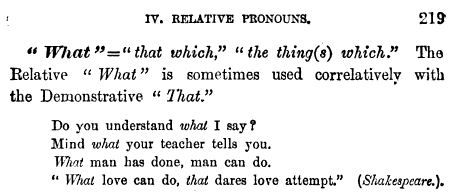時間と懐にあまり余裕がなかったので遅くなってしまったのですが、ようやく北村 (2021) を買うことになりました。個人的な感想としては、ツイートですでに読んだことのある事項や文が多かったのですが、何と言ってもこのような本が一般書として売られたという事実に改めて驚嘆せざるをえませんでした。小説にほとんど興味のない人でも「文法・語法コラム」には非常に重要でありながら類書になかなか書かれていない事項があるので、この部分だけでも 2420 円の価値はあると個人的に思います。
追記. 正誤表が公式 HP から入手できます。
5.5 例題4
さて、本稿は 5.5 節の例題4 に補足を加えることを主眼としています。
“But I will take it from him; it is a terrible emergency and the act is thereby justified. And if it were not so, who will give law to the Church? The Church giveth law to all; and what she wills to do, that she may do, hurt whom it may. I will take it from him; you shall begin upon the moment.”
(Mark Twain (1889): A Connecticut Yankee in King Arthur’s Court)
これに関連する記述を引用しましょう。ただしグロスを HTML 上で再現するのは大変なので、スペースを上手に汲み取って読んでください。
[...] この that は直前の what she wills to do「教会がしようとすること(全て)」を受け直す代名詞で、この文は that (O) she (S) may do (V) という構造になっていると考えるのが正解です。実は 4.3 節の【例題 4】の解説
where George is, there is my home. では、George がチャレンジャー教授の名前を表しています。なお、この文では「ジョージがいるところ、そこが私の家」と where... と there が呼応した形になっていますが、このように what, when, where などの疑問詞節で表現した内容を、代名詞 that や副詞 then, there で受け直す構造が古い英語では今よりも一般的に用いられていました。現在では、Where there is a will, there is a way. 「為せば成る」などの格言でのみ見られる形です。
で少しだけ触れた構造であり、詳細はこの後の[文法・語法コラム(15)]で説明します。
[...] 斎藤秀三郎『熟語本位英和中辞典(新版)』は「連関代名詞」の一例として、このように what と呼応する that を記述していて、What the cherry is among the flowers, that is the samurai among men. 「花は桜、人は武士」という例文も載せています。実は『ロミオとジュリエット』のバルコニーシーンのロミオのセリフにも、この構造は登場します。
(1) And what love can do, that dares love attempt.
(William Shakespeare: Romeo and Juliet)
[訳] そして、愛にできることは何でも、愛はやろうとする。[...] これこそまさにドイツ語のような構造ですよね。実際、what...that のようなタイプの呼応自体もドイツ語においてはより一般的で、次のような言い方が珍しくありません。
(2) Was ich habe, das kann ich geben.
逐語英訳 what I have that can I give
日本語訳 私が持っているものは与えることができる。
補足一・二:斎藤氏の記述
まず斎藤秀三郎『熟語本位英和中辞典』はすでに著作権が切れており、国立国会図書館のデジタルコレクションで閲覧することができます。該当する記述は次の通りです。

一つ目の補足は、斎藤氏は Practical English Grammar(リンク先の Google Books で自由に閲覧することができます)で『ロミオとジュリエット』の文に言及しているということです。

二つ目は、ここで「連関代名詞」が一体どのような意味で用いられているのかについてです。次の記述をご覧ください。
§8. 連関代名詞英語には, 連関代名詞 (Correlative Pronoun) が二種類ある:—
(a) 指示詞 (Demonstrative) が関係詞 (Relative) に先立つ場合, 即ち “that...which” (those...who, then...when, there...where) の順序のもの:—(α) That...which:—The p[r]oject excited that interest which novelty commands. (その企画は新奇なものゝ必ず呼起すあの興味を惹いた)
(β) Such...as:—Such of the students as persevered, were successful. (学生のうち辛抱強かった者が成功した)
(γ) The same...as:—I have the same right as you have. (私は君と同一の権利が有る)
(δ) As...as:—I have as good a right as you have. (私は君と同じ立派な権利が有る)
(ε) So...as:—You have not so good a right as I have. (君は私ほど立派な権利が無い)(b) 関係詞が指示詞に先立つ場合, 即ち “what...that” (when...then, where...there, how...so) の順序のもの:—
(α) What...that:—What the lion is among beasts, that is the eagle among birds. (獣類中の獅子の地位が, それが鳥類中の鷲の地位である. 獅子が百獣の王たるが如く, 鷲は百鳥の王である)
(β) As...so:—As the lion is the king of beasts, so is the eagle the king of birds. (同上)
(γ) The...the:—The more one has, the more one craves. (人は沢山持っていればいるほど, 益々沢山欲しがる. 隴を得て蜀を望む)【註】相関詞 such...that, so...that の “that” は, 結果節 (Consecutive Clause) を導く接続詞であって関係詞ではないから, その短縮形 such...as to, so...as to と共に, この表に加えない.
齋藤秀三郎. (1956). 代名詞用法詳解. 吾妻書房.
なるほど、こういう意味合いだったのですね。
補足三:言語学での呼称
ところで、この「what...that の呼応」という現象に何か名前は付いていないのでしょうか。実は東大出版から出ている『言語学 第2版』の p. 158 にちゃんと記述があり、コラムの文 (2) と同型の例文が挙げられています。
関係節構造として比較的よくみられるものには, この〔引用者注:先行型と後行型の〕ほかに, 次の例のような相関型の構文がある.
(21) 相関型関係節構造の例
- ドイツ語
[Wem ich zuerst begegne,] den frage ich.
誰(与格) 私が 最初に 出会う それ(対格) 尋ねる 私が
「最初に出会った人に, 私は質問しよう」- ロシア語
[Kto ne rabotaet,] tot ne est.
誰(主格) 否定 働く それ(主格) 否定 食べる
「働かざるもの食うべからず」- マリ語
[kö-m vučəšna,] tudo tolən.
誰(対格) 待つ(1複) 彼(主格) 来た(3単)
「私たちが待っていた人がやってきた」この構造が相関的と呼ばれるのは, 関係節のなかに現れている疑問詞と主文のなかの指示詞が, (21a) の wem—den, (21b) の kto—tot, (21c) の köm—tudo のように, 指示詞が疑問詞を受ける形で対になって対応しているからである.
風間喜代三, 上野善道, 松村一登, 町田健. (2004). 言語学 第2版. 東京大学出版会.
実際の分布や Dryer 氏による記述は次のリンクをご覧ください。
補足四:他の用例
John Lockeの英文を読むために必要な英文法(7)
— MR. BIG (@Kazuma_Kitamura) August 16, 2018
where…there、when…then、what…thatなど、wh節をth-wordsで受け直す呼応関係。
例: Where a wrong bent of the Will, wants hot amendment, there can be no need of Blows.
例: What the mind is intent upon, and careful of, that it remembers best, and for the reason above-mentioned:
— MR. BIG (@Kazuma_Kitamura) August 16, 2018
[クイズ]
— MR. BIG (@Kazuma_Kitamura) March 28, 2020
I was bewildered; it seemed a thing so hopeless he was asking—he, the old buccaneer, the ringleader throughout.
“What I can do, that I'll do,” I said.
”What...I'll do"の述語動詞は?
他にも欽定訳聖書は良い宝庫になると思います。簡単に見つかった範囲で以下に示します。
- What I tell you in darkness, that speak ye in light: and what ye hear in the ear, that preach ye upon the housetops. (Matthew 10:27)
- Where no wood is, there the fire goeth out: (Proverbs 26:20)
- Now where remission of these is, there is no more offering for sin. (Hebrews 10:18)
- and where the slain are, there is she. (Job 39:30)
- Where the word of a king is, there is power: (Ecclesiastes 8:4)
ところで、特に what…that の受け直しを左方転位(left dislocation)と理解するのは、情報構造の観点と右方転位できないという事実から、困難であるように思われます。じゃあ何なのかという話になりますが、私はこの現象に関する記述をほとんど見かけたことがないのでわかりません。どうせ Jespersen とか Visser とかに書いてあるんじゃないのという話にはなったんですが、ざっと見た限りどっちにも見当たりませんでした。
そういえば、右方転位について enwp に面白い話が載っていました。
A second strategy is the correlative-clause strategy used by Hindi and other Indo-Aryan languages, as well as Bambara. This strategy is equivalent to saying "Which girl you see over there, she is my daughter" or "Which knife I killed my friend with, the police found that knife". It is "correlative" because of the corresponding "which ... that ..." demonstratives or "which ... she/he/it ..." pronouns, which indicate the respective nouns being equated. The shared noun can either be repeated entirely in the main clause or reduced to a pronoun. There is no need to front the shared noun in such a sentence. For example, in the second example above, Hindi would actually say something equivalent to "I killed my friend with which knife, the police found that knife".